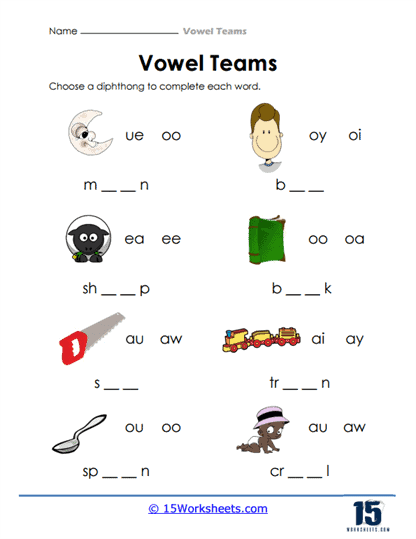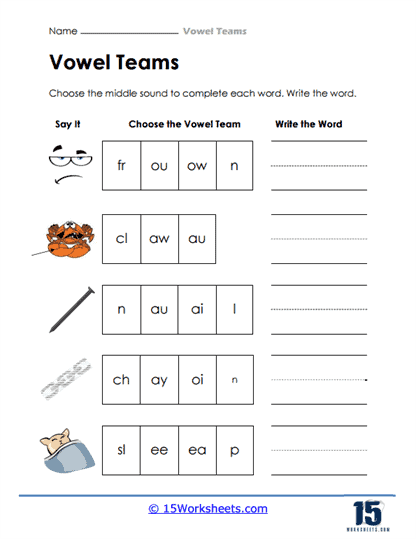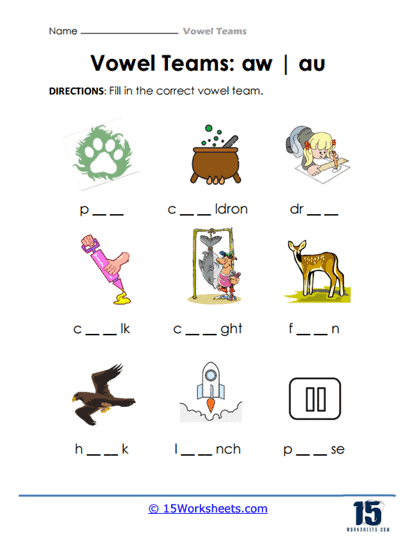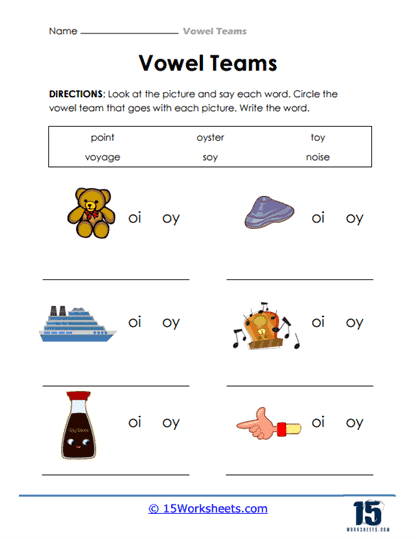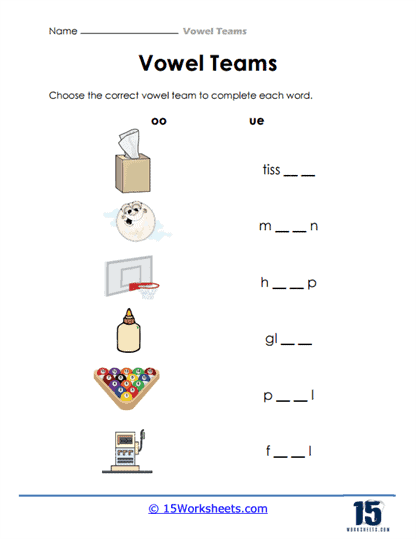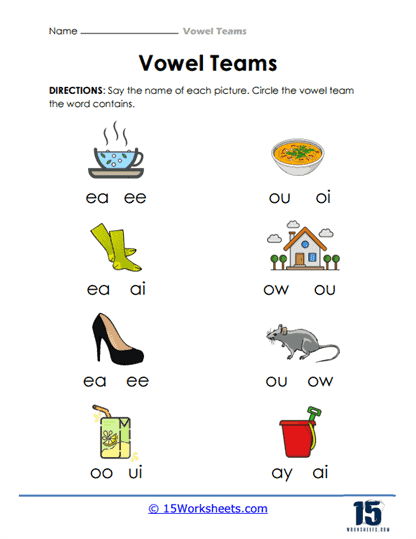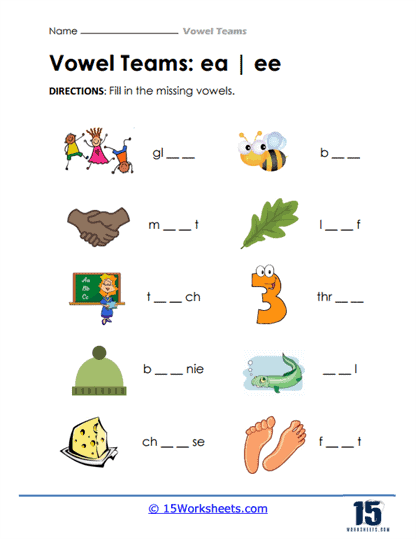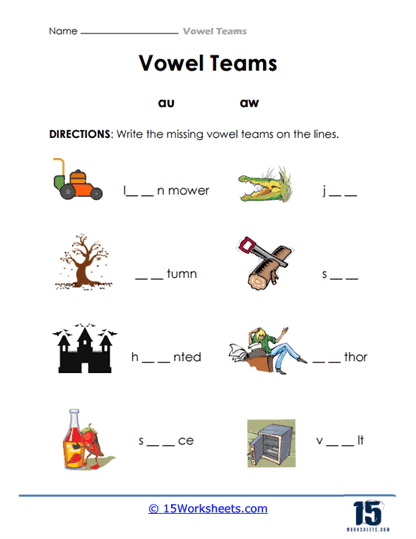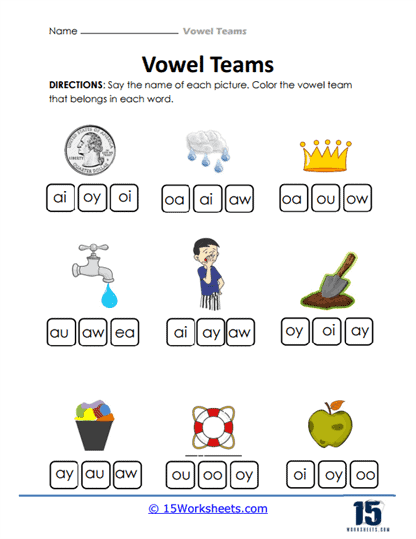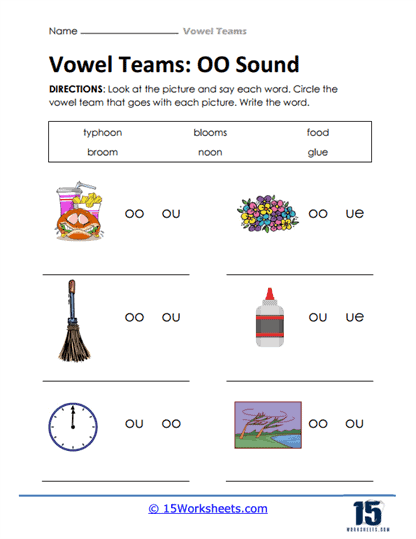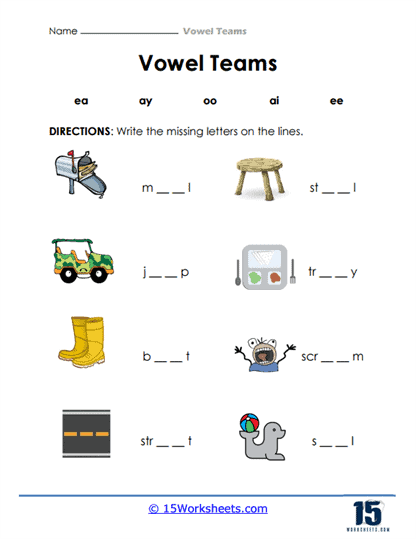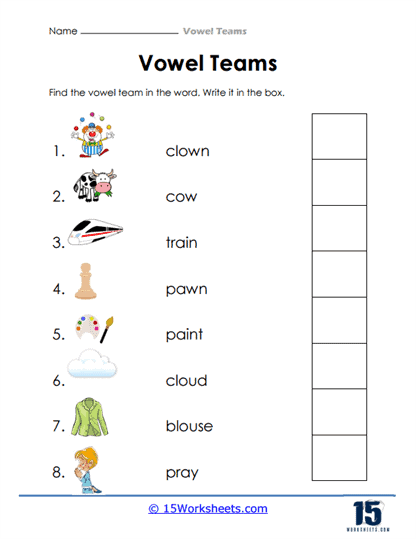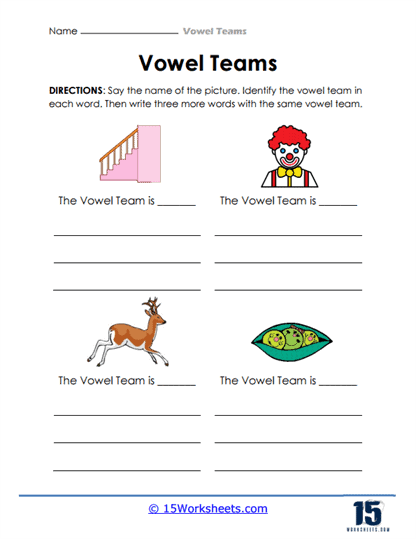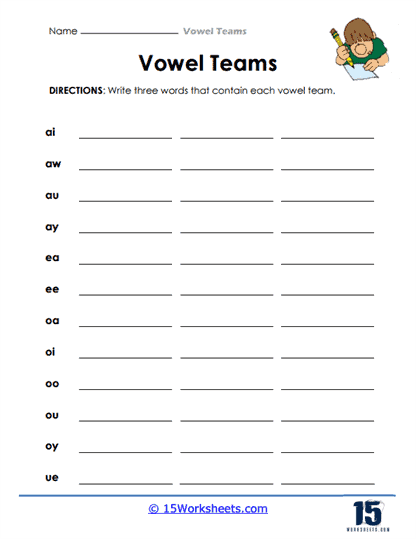Vowel Teams Worksheets
All About These 15 Worksheets
Vowel teams, often referred to as vowel combinations or digraphs, are a fascinating and vital component of phonics and early literacy education. These pairs or groups of vowels work together to create unique sounds in words, and understanding them is essential for young learners. Proficiency in vowel teams is pivotal for reading, spelling, and overall language development.
To empower students with the skills needed to navigate vowel teams effectively, we proudly present a collection of Vowel Teams worksheets. These worksheets are meticulously designed to provide students with structured and engaging opportunities to practice and refine their understanding of vowel teams.
What Are Vowel Team Worksheets?
Vowel team worksheets can support the literacy development of young learners, particularly in the area of phonics. The main purpose of these worksheets is to enable students to understand and master the concept of vowel teams, also referred to as vowel pairs or vowel digraphs. Vowel teams are when two vowels are placed together to produce a single sound, such as “ee”, “ai”, “oa”, “oi”, “ou”, and “ue”.
To truly grasp the complexities of English pronunciation and reading, it is essential for students to learn vowel teams. Their significance is profound because they often produce sounds that do not conform to the individual vowel sounds the students might have learned previously. This can make vowel teams tricky to recognize and pronounce correctly, hence the necessity of vowel team worksheets to provide practice and reinforcement.
There are various types of exercises that one would expect to see in these vowel team worksheets, each of which is designed to bolster a different aspect of literacy skills:
Identification – These exercises typically involve a list of words in which students need to identify and highlight the vowel team. This encourages them to recognize vowel teams within the context of whole words, strengthening their visual discrimination skills and phonetic awareness.
Sorting Exercises – In these exercises, students are given a range of words and asked to sort them into categories based on the vowel team they contain. This helps to consolidate their understanding of vowel teams, encourages pattern recognition, and promotes critical thinking skills.
Fill-in-the-blanks – Here, students are provided sentences with missing words that they must complete using words with specific vowel teams. These exercises test their understanding of the vowel teams and their application in different contexts, thus boosting their comprehension and sentence construction skills.
Matching Exercises – These exercises involve matching words with their corresponding pictures or definitions. This exercise helps students associate words containing vowel teams with their meanings or representations, fostering vocabulary development and reading comprehension skills.
Pronunciation Practice – Students might also be asked to read aloud words or sentences containing specific vowel teams. This provides practice in pronunciation, enhances fluency, and reinforces the correct phonetic sounds of different vowel teams.
Spelling Exercises – These exercises require students to spell words using vowel teams correctly. This helps solidify their understanding of the teams’ use in different words and develops their spelling and writing skills.
Puzzles – These fun exercises aid in reinforcement of vowel teams within a more engaging context. They improve the students’ concentration, word recognition, and recall skills.
Each type of exercise contributes to reading improvement in different ways. Identification exercises lay the groundwork for other skills, creating a strong base for recognizing vowel teams in reading. Sorting exercises deepen understanding of vowel teams and build cognitive skills necessary for reading comprehension. Fill-in-the-blanks and matching exercises encourage the application of learned knowledge, further cementing understanding and improving vocabulary usage.
Pronunciation exercises directly impact reading fluency, helping students move from decoding words to reading more fluidly. Spelling exercises, on the other hand, improve writing skills, which are often closely tied to reading skills. Finally, puzzles offer a fun, engaging way to reinforce learned knowledge and provide repeated exposure to vowel teams, improving both recognition speed and reading fluency over time.
The variety and design of these exercises ensure they cater to different learning styles. This increases the effectiveness of the worksheets, as they provide visual, auditory, and kinesthetic learning opportunities. Students who struggle with one type of exercise may find another easier and more enjoyable, allowing for differentiation and personalized learning.
What Are Vowel Teams?
Vowel teams, also known as vowel digraphs or vowel pairs, refer to two vowels that come together to create a single sound. This sound may be unique and not related to the individual sounds of the vowels that make up the team.
Here are three examples of vowel teams:
“ea” – This vowel team can make a long “e” sound as in ‘beach’ or a short “e” sound as in ‘bread’.
“oa” – This vowel team typically makes a long “o” sound, as in ‘boat’ or ‘toast’.
“ie” – This vowel team can make a long “i” sound as in ‘pie’ or a long “e” sound as in ‘believe’.
Remember, the pronunciation of vowel teams can be influenced by the context of their use within words, which is why learning to recognize and properly pronounce vowel teams is an important part of developing reading skills.
What Is the Difference Between a Vowel Team and a Digraph?
A digraph refers to a combination of two letters that make a single sound. This can involve either vowel or consonant letters. For example, the ‘ch’ in ‘chat’, ‘sh’ in ‘ship’, ‘th’ in ‘think’, and ‘wh’ in ‘when’ are examples of consonant digraphs. On the other hand, ‘ai’ in ‘rain’, ‘ee’ in ‘see’, ‘oa’ in ‘boat’, and ‘ue’ in ‘glue’ are examples of vowel digraphs. So, a digraph could be a pair of vowels, a pair of consonants, or a vowel and a consonant.
A vowel team, however, specifically refers to two vowels that work together to make one sound. Some vowel teams make a new sound that’s different from the sounds of the individual vowels, like ‘oa’ in ‘boat’ or ‘ee’ in ‘see’. Other times, one of the vowels is silent, and the other makes a long vowel sound, like ‘ea’ in ‘eat’ or ‘ai’ in ‘rain’.
In summary, the term ‘digraph’ is a broader term encompassing any two letters that produce one sound, whereas ‘vowel team’ specifically describes two vowels that together produce a single sound. All vowel teams can be considered as digraphs (more specifically, vowel digraphs), but not all digraphs are vowel teams, as digraphs can also be composed of two consonants or a consonant and a vowel.
The Importance of Vowel Teams
The mastery of vowel teams is a cornerstone of reading and literacy development. Vowel teams, which are pairs of vowels that work together to produce a specific sound, can be tricky for students to grasp, but they are essential for achieving reading fluency and proficiency. This is because vowel teams often break the standard phonetic rules that students learn in their early years, making them a critical but complex area of focus. The collection of worksheets centered on vowel teams serves as an invaluable tool for educators and parents who want to help students develop strong phonics and reading skills. By mastering vowel teams, students gain a deeper understanding of the English language, which enhances their ability to read, spell, and communicate effectively.
One of the primary reasons understanding vowel teams is so important is that it directly impacts reading proficiency. Vowel teams such as “ea” in “bread” or “ee” in “tree” allow students to decode words accurately, which is essential for fluent reading. When students encounter a word with a vowel team, being able to recognize that the two vowels together create a specific sound enables them to read the word quickly and correctly. For instance, without understanding the vowel team “ai” in “rain,” a student might stumble over the word or mispronounce it. These worksheets guide students through recognizing, pronouncing, and using vowel teams, gradually building their confidence and fluency. As they progress through these activities, students will find that their ability to tackle unfamiliar words improves, which in turn boosts their overall reading comprehension.
Spelling is another area that benefits significantly from understanding vowel teams. English spelling can be notoriously difficult, especially when it comes to words with vowel combinations that don’t always follow phonetic rules. Mastery of vowel teams helps students not only pronounce words correctly but also spell them with greater accuracy. For example, distinguishing between the vowel teams “ea” in “bead” versus “ee” in “reed” is crucial for both pronunciation and correct spelling. The worksheets provided offer engaging spelling exercises that allow students to practice and internalize these patterns. For instance, students might be asked to fill in the missing vowel teams in a list of words, reinforcing their ability to identify the correct spelling patterns. Over time, these exercises strengthen students’ spelling competence, helping them avoid common mistakes and build confidence in their written language skills.
Phonemic awareness-the ability to hear, identify, and manipulate individual sounds in words-is another critical literacy skill that is developed through these vowel team worksheets. Phonemic awareness is the foundation for reading and spelling because it allows students to understand how sounds correspond to letters and letter combinations. Working with vowel teams challenges students to break words down into their individual sounds, which enhances their ability to manipulate and blend those sounds. For example, by practicing with the vowel team “ou” in “house,” students learn to separate the sound “h” from the “ou” and blend them together to form the word. This type of activity fosters stronger phonemic awareness, which is crucial for young readers as they move from simple word recognition to more advanced reading tasks that involve unfamiliar or multisyllabic words.
In addition to improving reading and spelling, these vowel team worksheets also contribute to vocabulary growth. When students learn and practice vowel teams, they are exposed to a wider range of words and language patterns. For instance, working on vowel teams like “ea” might introduce them to words such as “beach,” “steam,” and “plead,” all of which help expand their vocabulary. The worksheets often include contextual exercises where students are asked to use words with vowel teams in sentences or stories, allowing them to see how these words function in real language use. As students become more comfortable with vowel teams, they are not only improving their phonics skills but also enriching their understanding of the English language. This broadens their vocabulary, which is essential for both reading comprehension and effective communication.
The engaging nature of these worksheets ensures that students remain interested and motivated as they practice these vital skills. The worksheets incorporate a variety of activities-such as matching games, word searches, and sentence completions-that keep learning fun and dynamic. For example, a word search might challenge students to find and circle all the words containing specific vowel teams like “ai” or “oo.” These interactive exercises ensure that students stay engaged while reinforcing the phonics rules they are learning. The repetitive yet varied nature of the tasks helps students retain information over time, allowing them to apply what they’ve learned to new reading and spelling challenges.


